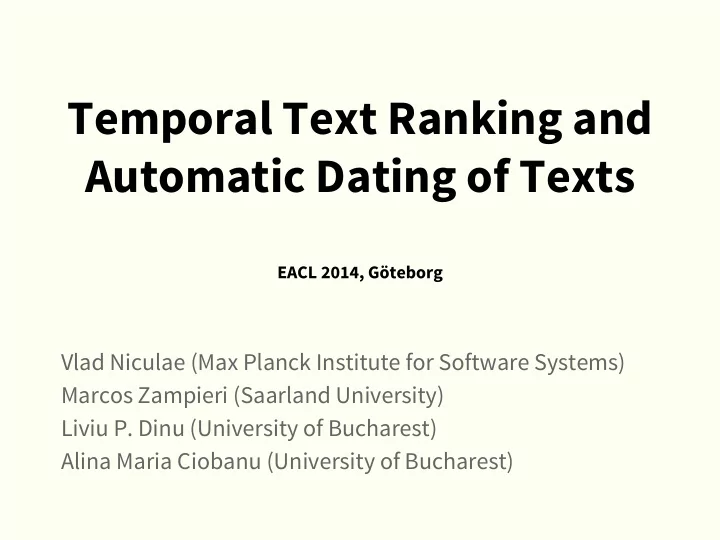

Temporal Text Ranking and Automatic Dating of Texts EACL 2014, Göteborg Vlad Niculae (Max Planck Institute for Software Systems) Marcos Zampieri (Saarland University) Liviu P. Dinu (University of Bucharest) Alina Maria Ciobanu (University of Bucharest)
1. Text Dating Estimate the writing date of a text. (Linguistic complement to material dating. )
1. Text Dating Estimate the writing date of a text. (Linguistic complement to material dating. ) ● 1930? 1899? 1823? (Regression) (Preoțiuc-Pietro and Cohn, 2013) ● 18th / 19th century? (Classification) (de Jong et al, 2005) and our previous work
1. Text Dating Estimate the writing date of a text. (Linguistic complement to material dating. ) ● Which is newer?
1. Text Dating Estimate the writing date of a text. (Linguistic complement to material dating. ) ● Which is newer? 1899 . W. Crane, A Floral Fantasy 1667 . An Account Of The Experiment Of in an Old English Garden Transfusion Practiced Upon A Man In London
2. This Work: Pairwise Ranking Input: pairs of documents Output: “ ≺ ”, “ ≻ ” Not all input samples need to be comparable. 1690 1740 1889 1923 1800
2. This Work: Pairwise Ranking Input: pairs of documents Output: “ ≺ ”, “ ≻ ” Not all input samples need to be comparable. 1690 1740 1889 1923 1700 − 1800
3. Behind the Scenes Binary classification of pairs. g ( d 1 , d 2 ) > 0 But we want the dates, not a ranking!
3. Behind the Scenes Binary classification of pairs. g ( d 1 , d 2 ) > 0 But we want the dates, not a ranking! w ⋅ ( d 1 - d 2 ) > 0 w ⋅ d 1 > w ⋅ d 2
3. Behind the Scenes Binary classification of pairs. g ( d 1 , d 2 ) > 0 But we want the dates, not a ranking! w ⋅ ( d 1 - d 2 ) > 0 w ⋅ d 1 > w ⋅ d 2 Use a moment in time instead of a document: w ⋅ d 1 > θ (1850)
Evaluation
4. Historical Corpora Three languages: ● Colonia Corpus of Historical Portuguese (Zampieri and Becker, 2013) ● Corpus of Late Modern English Texts (CLMET) (de Smet, 2005) ● Romanian Historical Corpus (Ciobanu et al. 2013)
5. Simple Features A. lexical (word counts) B. naive morphological (character n-grams at the end of words) + feature transformation and selection
6. Results Comparable to the regression approach Ridge pairwise pairwise size score score en 293 83.8% 83.7% pt 87 82.9% 81.9% ro 42 92.9% 92.4% our system
7. Function estimation ( θ ) w ⋅ x (projection of documents onto a rank-preserving line) Year
8. Function estimation (Romanian)
9. Function estimation (English)
10. Function estimation (Portuguese)
11. Dating uncertain texts C. Cantacuzino (1650 − 1716), Istoria Țării Rumânești Important historical work, contested writing time. Published: 19th century.
11. Dating uncertain texts C. Cantacuzino (1650 − 1716), Istoria Țării Rumânești Important historical work, contested writing time. Published: 19th century. We predict 1736.2 − 1753.2:
12. Conclusion & Future Work ● ranking approach to temporal modelling ● important gain on flexibility ● acceptable performance with simple features
12. Conclusion & Future Work ● ranking approach to temporal modelling ● important gain on flexibility ● acceptable performance with simple features ● application-specific feature engineering ● other historical corpora wanted!
Recommend
More recommend